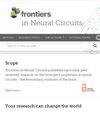An operating principle of the cerebral cortex, and a cellular mechanism for attentional trial-and-error pattern learning and useful classification extraction
IF 3
3区 医学
Q2 NEUROSCIENCES
引用次数: 0
Abstract
A feature of the brains of intelligent animals is the ability to learn to respond to an ensemble of active neuronal inputs with a behaviorally appropriate ensemble of active neuronal outputs. Previously, a hypothesis was proposed on how this mechanism is implemented at the cellular level within the neocortical pyramidal neuron: the apical tuft or perisomatic inputs initiate “guess” neuron firings, while the basal dendrites identify input patterns based on excited synaptic clusters, with the cluster excitation strength adjusted based on reward feedback. This simple mechanism allows neurons to learn to classify their inputs in a surprisingly intelligent manner. Here, we revise and extend this hypothesis. We modify synaptic plasticity rules to align with behavioral time scale synaptic plasticity (BTSP) observed in hippocampal area CA1, making the framework more biophysically and behaviorally plausible. The neurons for the guess firings are selected in a voluntary manner via feedback connections to apical tufts in the neocortical layer 1, leading to dendritic Ca大脑皮层的工作原理,以及注意力试错模式学习和有用分类提取的细胞机制
智能动物大脑的一个特点是能够学会用与行为相适应的活跃神经元输出集合对活跃神经元输入集合做出反应。在此之前,有人提出了一种假设,说明这种机制是如何在新皮层锥体神经元的细胞水平上实现的:顶端突起或周围突起输入启动 "猜测 "神经元搏动,而基底树突则根据兴奋的突触簇识别输入模式,并根据奖赏反馈调整簇的兴奋强度。这种简单的机制能让神经元以令人惊讶的智能方式学会对输入进行分类。在这里,我们对这一假设进行了修正和扩展。我们修改了突触可塑性规则,使之与在海马 CA1 区观察到的行为时标突触可塑性(BTSP)相一致,从而使该框架在生物物理和行为学上更加合理。猜测发射的神经元通过与新皮层第 1 层顶端束的反馈连接,以自愿的方式进行选择,从而导致树突 Ca2+ 穗状突发性发射,这被假定为注意力和意识处理的神经关联。神经元输入的分类一旦学会,就会在没有自主或有意识控制的情况下执行,从而实现分类的分层递增学习,这在我们固有的可分类世界中非常有效。除了自主性之外,我们还提出锥体神经元突发性发射也可以是非自主性的,也是通过顶端簇输入启动的,从而将注意力吸引到新奇和有害刺激等重要线索上。我们根据神经皮质锥体神经元的兴奋途径将其分为四类:注意与自动、自愿/后天与非自愿。此外,我们还假设锥体神经元小柱束内的树突通过去极化交叉诱导耦合在一起,从而使小柱功能得以实现,如创建强大的分层 "超神经元 "和外部世界的内部表征。我们提出了将微电路理论扩展到网络级处理的构建模块,有趣的是,这将产生类似于目前使用的人工神经网络的变体。从更推测性的角度来看,我们猜想,在受某些类型物理定律支配的宇宙中,智能的原理可能与我们的宇宙相似。
本文章由计算机程序翻译,如有差异,请以英文原文为准。
求助全文
约1分钟内获得全文
求助全文
来源期刊

Frontiers in Neural Circuits
NEUROSCIENCES-
CiteScore
6.00
自引率
5.70%
发文量
135
审稿时长
4-8 weeks
期刊介绍:
Frontiers in Neural Circuits publishes rigorously peer-reviewed research on the emergent properties of neural circuits - the elementary modules of the brain. Specialty Chief Editors Takao K. Hensch and Edward Ruthazer at Harvard University and McGill University respectively, are supported by an outstanding Editorial Board of international experts. This multidisciplinary open-access journal is at the forefront of disseminating and communicating scientific knowledge and impactful discoveries to researchers, academics and the public worldwide.
Frontiers in Neural Circuits launched in 2011 with great success and remains a "central watering hole" for research in neural circuits, serving the community worldwide to share data, ideas and inspiration. Articles revealing the anatomy, physiology, development or function of any neural circuitry in any species (from sponges to humans) are welcome. Our common thread seeks the computational strategies used by different circuits to link their structure with function (perceptual, motor, or internal), the general rules by which they operate, and how their particular designs lead to the emergence of complex properties and behaviors. Submissions focused on synaptic, cellular and connectivity principles in neural microcircuits using multidisciplinary approaches, especially newer molecular, developmental and genetic tools, are encouraged. Studies with an evolutionary perspective to better understand how circuit design and capabilities evolved to produce progressively more complex properties and behaviors are especially welcome. The journal is further interested in research revealing how plasticity shapes the structural and functional architecture of neural circuits.
 求助内容:
求助内容: 应助结果提醒方式:
应助结果提醒方式:


